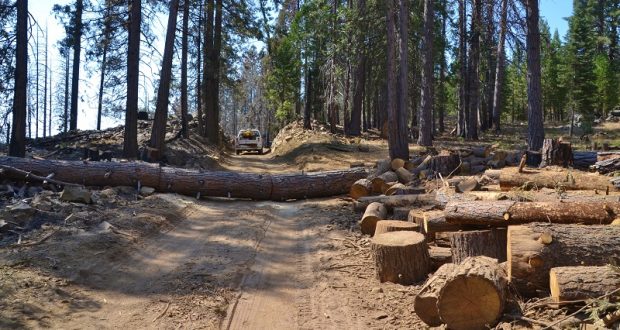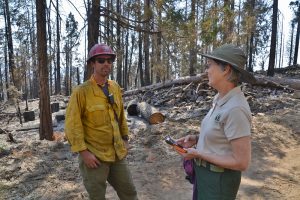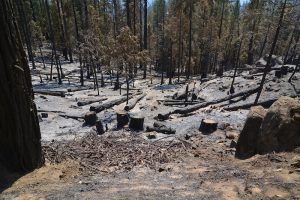YOSEMITE – Though the firefight has ended on the nearly 97,000-acre Ferguson Fire and only a few smokes remain throughout the interior, the work of repair and restoration continues.
On a recent trip to Yosemite West, I was escorted by Anne Grandy, retired from the Bass Lake Ranger District and now serving as a PIO on the South Central Sierra Interagency Incident Management Team, which served two stints managing the Ferguson Fire.
We were shown first-hand where firefighters made their stand to save the community, the massive amount of work that went into that effort, and the equally daunting process in which they are now engaged to repair the damage done during suppression efforts.
Parker Bevington, Engine Captain at the Wawona Fire Station in Yosemite National Park, was the Division Boss in Division H on the fire – the area on the northeast corner where firefighters stopped the forward progress before the fire reached Yosemite Valley, and kept it from destroying Yosemite West and the ski area at Badger Pass.
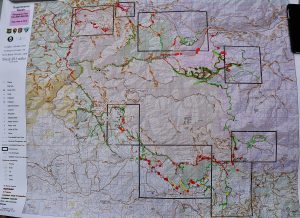 Bevington is now the Division Supervisor for the Yosemite Group, which is working to repair suppression damage all across the fireline from Wawona to El Portal and Foresta. This is his section of the 251 miles of fireline that will be repaired in the coming months.
Bevington is now the Division Supervisor for the Yosemite Group, which is working to repair suppression damage all across the fireline from Wawona to El Portal and Foresta. This is his section of the 251 miles of fireline that will be repaired in the coming months.
On the day of our visit, about 25 people were hard at work on the southeast corner of Yosemite West near the site of an old logging camp. While there were about 300 people defending this section of line during the firefight, that number has been reduced to less than 10 percent doing the massive job of repair work.
Back in July when it was clear that the Ferguson Fire was headed toward the community across steep, inaccessible terrain, heavy with beetle-kill trees and dense fuel loads, firefighters prepared to defend around Yosemite West and along Highway 41. The heavy inversion layer in the days before the fire arrived gave crews time to construct several contingency lines ahead of the leading edge.
“That nasty inversion we had for about a week was a miracle,” said Bevington. “We were blessed to have it. If we hadn’t, it could have been just like the Rim Fire with those 50,000 foot columns, and it would have all been gone. Though the inversion kept the aircraft from flying, it also kept a lid on our jar. When you get into this decadent timber that’s overloaded with millions upon millions of dead trees, you can drop retardant on it all day and it’s not going to stop it.”
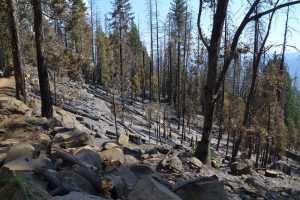 Firefighters used that time to remove the fuel inside their line. They dropped about 80 percent of the trees within one chain (66 feet) of the road on the “black” side, all of which were dead.
Firefighters used that time to remove the fuel inside their line. They dropped about 80 percent of the trees within one chain (66 feet) of the road on the “black” side, all of which were dead.
They then cut them into thousands of huge rounds and with no processors or skidders available, firefighters rolled them – uphill mind you – into the “green” and fired off that section of line so that when the leading edge of the fire arrived, there was no fuel left to burn.
The firefight around Yosemite West, and in fact across any fire of size, was planned and executed not only to save lives and property, but also to preserve natural, cultural and other resources across the landscape.
Resource Advisors, or READs, are an integral and largely unrecognized part of suppression activity and the repair process after the fire is contained. They are brought in right from the beginning to identify areas that need to be protected. Each division on the fire has at least one READ assigned.
All READs who work on the fireline are called REAFs (Resource Advisor – Fireline) and receive the same Basic 40 training as all other firefighters. They come from a wide range of experience levels, professional backgrounds and agencies.
While firefighters are focused on stopping the fire, they also don’t want to run a dozer line through an ancient burial ground or destroy the nesting ground of an endangered species. READs identify those areas so that fire managers can avoid them. They assist with planning suppression actions such as scouting lines, digging handline, putting out spot fires, placing hoselays and repairing damaged areas.
On the Ferguson Fire, there are READs with decades of experience and a variety of other fireline qualifications:
- Tribal members
- Engine crews
- Task force leaders
- Crew bosses
- Firefighter Types 1 and 2
- Helicopter crew members
- Heavy equipment operators and bosses
- Suppression repair specialists
- Cultural specialists
- Specialists in Geographic Information Systems (GIS) mapping technology
- Timber fallers
- Wilderness specialists
- Emergency medical technicians
- Low-angle rope rescue technicians
Most people on the fireline know them as scientists – archeologists, ecologists, hydrologists, wildlife biologists, soil scientists, foresters and silviculturalists.
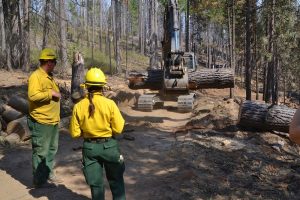 READs write a suppression repair plan with input from various agency administrators and fire personnel, collaborate with Task Force Leaders, Heavy Equipment Bosses, and Heavy Equipment Operators, and collaborate with local tribal governments and provide escort missions for tribal personnel who want to visit sensitive areas, as long as it is safe to do so.
READs write a suppression repair plan with input from various agency administrators and fire personnel, collaborate with Task Force Leaders, Heavy Equipment Bosses, and Heavy Equipment Operators, and collaborate with local tribal governments and provide escort missions for tribal personnel who want to visit sensitive areas, as long as it is safe to do so.
Some of their notable efforts on the Ferguson Fire included protecting historic structures such as Henness Ridge and Trumbull Peak Lookouts, and the Merced Grove Cabin; helping rangeland permitees track down lost animals; protecting owl nests, pacific fisher nests, fish and amphibian habitat; protecting bears and other animals by making sure proper food storage containers were in place; repairing areas used by fire personnel for camps; informing air operations about good places to access water, where to place heliwells and retardant plants, where to avoid dropping retardant; helping private landowners file claims if they have property that was saved by suppression efforts, but also damaged by suppression activities; identification of previously undiscovered archeological sites; and avoiding or minimizing the spread of noxious weeds.
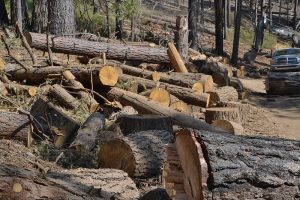 On the day of our visit to Yosemite West, an old logging camp from the Sugar Pine Lumber Company had been flagged for protection by one of the Yosemite Group’s READs. The crews were moving the heavy rounds that had been cut inside the fireline, and piling them outside the flagged area.
On the day of our visit to Yosemite West, an old logging camp from the Sugar Pine Lumber Company had been flagged for protection by one of the Yosemite Group’s READs. The crews were moving the heavy rounds that had been cut inside the fireline, and piling them outside the flagged area.
This time, they had heavy equipment assisting in their efforts. They were stacking burn piles and covering them with wax-covered paper to keep them dry. Then, when winter weather arrives and there is about a foot of snow on the ground, they will burn the piles when there is no chance of the fire creeping.
This is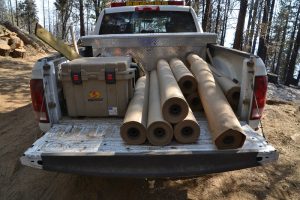 the third time some of these huge rounds have been moved. First they were rolled up the hill to create the wide fireline, then they were piled for burning. But with the identification of the logging camp site, some have to be moved again so as to avoid damage to the site.
the third time some of these huge rounds have been moved. First they were rolled up the hill to create the wide fireline, then they were piled for burning. But with the identification of the logging camp site, some have to be moved again so as to avoid damage to the site.
As fall arrives across the fire’s footprint, crews will continue to repair the firelines – both hand and dozer lines – by smoothing them out and using buck brush, branches and limbs to minimize erosion. The branches act as a screen so that as water starts to develop a flow it gets trapped and pools rather than rushing downhill.
They are also removing hazard trees from along the roadway. With most of the trees in this area having succumbed to the beetle attack or the ravages of the fire, that is a huge job. They must be taken down, bucked into chunks and piled for burning.
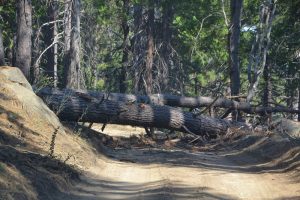 Just to put a fine point on the ever-present danger of all these dead trees, our way back out from the site was blocked by a tree that had fallen across the road just minutes before.
Just to put a fine point on the ever-present danger of all these dead trees, our way back out from the site was blocked by a tree that had fallen across the road just minutes before.
Our hosts got to work to cut it up and clear the road, but we were thankful we hadn’t left a few minutes earlier and been in the wrong place at just the wrong moment.
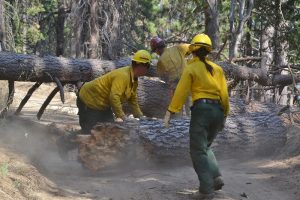 As we drove down the mountain from Yosemite West, we marveled at the skill and dogged determination of these firefighters who stopped the Ferguson Fire just feet from what would have been a monumental disaster. The fire burned around all sides of the community but not one of the nearly 200 structures was damaged or destroyed.
As we drove down the mountain from Yosemite West, we marveled at the skill and dogged determination of these firefighters who stopped the Ferguson Fire just feet from what would have been a monumental disaster. The fire burned around all sides of the community but not one of the nearly 200 structures was damaged or destroyed.
“It’s really easy to measure failure,” said Bevington. “You didn’t do your job and now it’s all destroyed. But it’s really difficult to measure success. You can’t possibly forecast the scope of success or the breadth of what might have been lost – how many lives, how many homes, how many firefighters didn’t get injured.”

